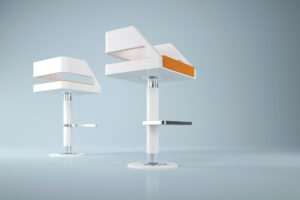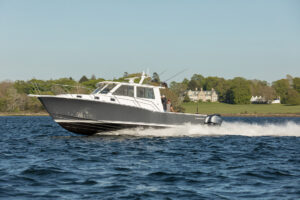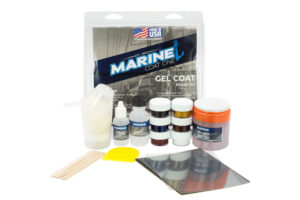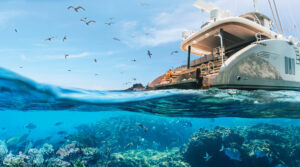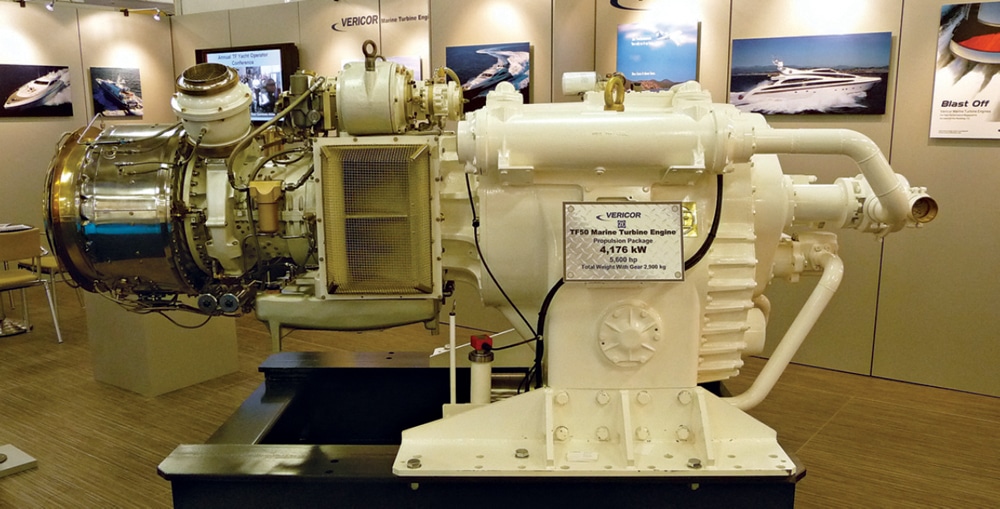
The Benefits of Gas-Turbine Engines
First, let’s dispel the myth that you need your own oil well to operate a boat powered by gas turbine engines. Yes, turbines can be a bit pricey and they’re generally not as fuel-efficient as diesel engines, but you don’t have to belong to OPEC to have a turbine.
Gas turbine engines are now offered by at least one production boatbuilder. Pershing Yachts (www.pershing-yacht.com), part of the Ferretti Group, completed its third 115-footer fitted with a turbine engine in 2011. The Vericor TF50 engine, built by a division of MTU, is linked to a centerline Kamewa waterjet and boosts the speed from the 35 or so knots achieved with twin MTU diesels into the rarified air north of 50 knots.
Among the more well-known custom yachts with a turbine is the 153-foot Feadship Detroit Eagle, delivered to Roger Penske in 2001. Her second owner has rechristened her Sea Racer and intends to use the turbine on a regular basis. Like the Pershing yacht, the Sea Racer also has a centerline TF50 employed in a configuration known as CODAG, an abbreviation for combined diesel and gas turbine. Such installations use diesel engines for normal cruising, and kick in the turbine to provide additional boost power for the occasional high-speed sprint.
Another configuration, CODOG, short for combined diesel or gas turbine, is best illustrated by the Wally Power 118. She has not one but three turbines, as well as two small diesels. When maneuvering in the harbor or puttering along at displacement speed, the Wally is under diesel power only. For planing operation, including both cruising and top speed, the diesels are shut down and the turbines provide the sole power — so the or in CODOG operation is what sets it apart from the and in CODAG.
What these three yachts have in common, besides the gas turbines, is consultant Tom Keefer, the principal at T3 Automation (www.t3automation .com), a company that specializes in gas turbine controls. His first response when I asked about the pros and cons of gas turbines was, “No vibration!” but he was quick to follow with the advantages of weight versus power. The TF50 package, he explained, with the new, more compact reduction-gear configurations now available specifically for coupling turbines to water jets or surface-piercing propellers, provides 5,600 horsepower and weighs in at around 5,400 pounds.
There are, of course, downsides to gas turbine engines — in their initial cost, their sensitivity to salt air and their specific fuel consumption when compared with diesels. Tom mentioned that, for some applications, smaller gas turbine engines are often available at bargain prices as surplus from military applications. And salt-air intrusion has been addressed by improved filtering systems in recent years, so it is not the concern it once was.
The problem of fuel consumption remains. The specific fuel rate for the TF50, for example, is about 0.064 gallons per horsepower-hour, compared with 0.050 to 0.055 for diesel engines, a penalty averaging about 20 percent. This is mitigated by two factors, however. First, the turbine weighs only a fraction of what a diesel engine providing the same power weighs, so there’s a bit of inherent savings there. Also, a turbine-powered yacht typically operates at top speed no more than 10 percent of the time, so the overall fuel premium will in all likelihood run less than 2 percent of the total fuel cost. And since fuel cost is only a fraction of overall operating costs, what looks at first blush to be a substantial penalty becomes insignificant in the total picture. In other words, we may see more gas turbine engines in the near future.

